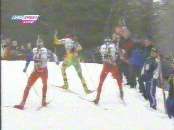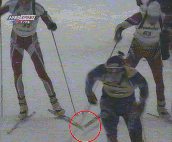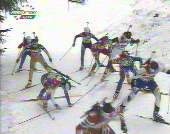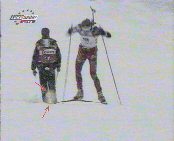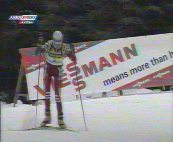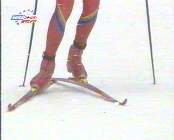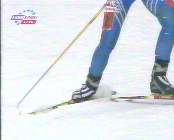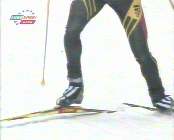The twisted-tip ("s-tip") ski construction has evident advantage at this situation.
To make You sure at this we offer to perform a simple tip collision experiment:
Put one of Your skis on the room floor on the edge position (like at the
final skating push-off phase). Putting on the edge the second ski try
to cross over the first one with it. Don't forget to simulate the skier
weight.
After that try to cross over the first ski with the all sliding tip surface,
not with the edge, of the second ski (put upper ski horizontal).
Sense the difference !
The twisted-tip ski construction provides just horizontal position of
the tip base at the last pushing off phase when entire ski is put on the
edge. (Look 3D model in patent
description).
The biathlonist moves the ski up ahead and the header rakes up the snow with its surface from the snow bank.
The biathlonist pulls the ski to himself but the on the header snow mass pulls it down .
The biathlonist moves as usual the ski to the first pushing off stage, but the lowered ski tip strikes onto the track and significantly brakes the skier movement.
The twisted-tip ski construction ("s-tip") at this situation would provide raising out of snow of the ski tip by the up ahead ski move.
The snow mass would not be raked up or be significantly less raked up at this situation. (Look 3D model in patent description).
By use the "parallelogram" ski ("r-shift") construction at this situation the on track ski strike would be damped and the snow raking up would be much less, because the internal edge has an obtuse angle. A twisted-tip ski would slide at this situation without significant resistance.
By the use the new construction ski this falls could be avoided.
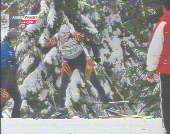
c4_2_mp.aviv(285k)
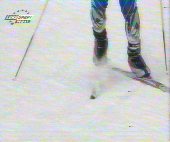
c4_mp.aviv(263k)
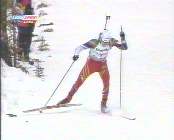
c4_3_mp.aviv(85k)
By use the "parallelogram" ski ("r-shift") construction at this situation the on track ski strike would be damped and the snow raking up would be much less, because the internal edge has an obtuse angle. Asymmetrical ski ("Slash") avoid the snow raking up by the ski tip and tail.
